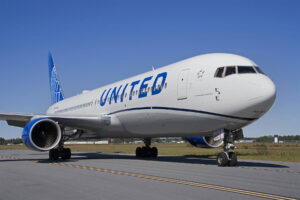More info? UA1639 Feb 16 2024 Rapid Descend
#1
FlyerTalk Evangelist
Original Poster
Join Date: Aug 2017
Programs: AS 75K, DL Silver, UA Platinum, Hilton Gold, Hyatt Discoverist, Marriott Platinum + LT Gold
Posts: 10,553
More info? UA1639 Feb 16 2024 Rapid Descend
Not seeing a lot of details for this online. How can that be?
Last Friday (Feb 16, 2024), UA1639 was scheduled to perform a red-eye OGG to SFO. Exactly 20 minutes after take off, cruise attitude was reached at 34,000 feet. About 9 minutes after, the aircraft descended more than 23,000 feet in span of 6-7 minutes, and leveled at 10,000 feet. 20 minutes thereafter, the decision was made to divert to HNL, and finally about an hour after that, the aircraft (738 - N77510) landed safely at HNL. Hours later, the same aircraft took off bound for SFO.
I only discovered this by accident, and tried to piece it together based on flight tracking info (see some below). There is a personal account reporting the rapid descend was due to loss of cabin pressure, and oxygen masks were dropped as a result.
Anyone with any additional details?

Last Friday (Feb 16, 2024), UA1639 was scheduled to perform a red-eye OGG to SFO. Exactly 20 minutes after take off, cruise attitude was reached at 34,000 feet. About 9 minutes after, the aircraft descended more than 23,000 feet in span of 6-7 minutes, and leveled at 10,000 feet. 20 minutes thereafter, the decision was made to divert to HNL, and finally about an hour after that, the aircraft (738 - N77510) landed safely at HNL. Hours later, the same aircraft took off bound for SFO.
I only discovered this by accident, and tried to piece it together based on flight tracking info (see some below). There is a personal account reporting the rapid descend was due to loss of cabin pressure, and oxygen masks were dropped as a result.
Anyone with any additional details?


#2
FlyerTalk Evangelist
Join Date: Apr 2006
Location: Los Angeles, California
Programs: United, American, Delta, Hyatt, Hilton, Hertz, Marriott
Posts: 14,831
Not seeing a lot of details for this online. How can that be?
Last Friday (Feb 16, 2024), UA1639 was scheduled to perform a red-eye OGG to SFO. Exactly 20 minutes after take off, cruise attitude was reached at 34,000 feet. About 9 minutes after, the aircraft descended more than 23,000 feet in span of 6-7 minutes, and leveled at 10,000 feet. 20 minutes thereafter, the decision was made to divert to HNL, and finally about an hour after that, the aircraft (738 - N77510) landed safely at HNL. Hours later, the same aircraft took off bound for SFO.
I only discovered this by accident, and tried to piece it together based on flight tracking info (see some below). There is a personal account reporting the rapid descend was due to loss of cabin pressure, and oxygen masks were dropped as a result.
Anyone with any additional details?

Last Friday (Feb 16, 2024), UA1639 was scheduled to perform a red-eye OGG to SFO. Exactly 20 minutes after take off, cruise attitude was reached at 34,000 feet. About 9 minutes after, the aircraft descended more than 23,000 feet in span of 6-7 minutes, and leveled at 10,000 feet. 20 minutes thereafter, the decision was made to divert to HNL, and finally about an hour after that, the aircraft (738 - N77510) landed safely at HNL. Hours later, the same aircraft took off bound for SFO.
I only discovered this by accident, and tried to piece it together based on flight tracking info (see some below). There is a personal account reporting the rapid descend was due to loss of cabin pressure, and oxygen masks were dropped as a result.
Anyone with any additional details?


I see it returned to SFO on Monday as UA3863.
#4
FlyerTalk Evangelist
Join Date: Apr 2006
Location: Los Angeles, California
Programs: United, American, Delta, Hyatt, Hilton, Hertz, Marriott
Posts: 14,831
Frankly, I�m jealous. I fly on the MAX in the hope of a bit of excitement. Perhaps the Alaska incident is a bit much, but a hissing with vapor condensation followed by a rapid dive would be nice. I now seem to live for things to break up the monotony of flying: someone blabbing on about switching seats or watching two passengers argue over an armrest just doesn�t cut it any more.
#5
Join Date: Feb 2002
Location: BNA
Programs: HH Gold. (Former) UA PP, DL PM, PC Plat
Posts: 8,199
The descent to 10,000' would indicate a loss of pressurization. They can not continue to crossing with a loss of pressurization prior to the equal-time-point. Once the pressurization was lost, there was no longer any possibility of containing to the mainland. The delay in turning back would have been going through the checklists and then getting the appropriate ATC clearance in the non-radar oceanic airspace.
This is all based only on the flight tracking data above. I don't have any other information on this particularly flight.
#6
FlyerTalk Evangelist
Join Date: May 2007
Location: Houston
Programs: UA Plat, Marriott Gold
Posts: 12,698
I agree with LarryJ, an immediate descent to 10,000 ft is likely a pressurization issue. Turning back is less urgent than descending, especially since they've got gobs of fuel on board they don't necessarily want to land with, and they've got checklists to run and ATC coordination to do.
Aviation Herald says the same, although I'm unclear if they had any source other than the same flight tracking data we're all looking at.
Aviation Herald says the same, although I'm unclear if they had any source other than the same flight tracking data we're all looking at.
#7
A FlyerTalk Posting Legend
Join Date: Apr 2004
Location: GVA (Greater Vancouver Area)
Programs: DREAD Gold; UA 1.035MM; Bonvoy Au-197; PCC Elite+; CCC Elite+; MSC C-12; CWC Au-197; WoH Dis
Posts: 52,159
#8
Join Date: Feb 2002
Location: BNA
Programs: HH Gold. (Former) UA PP, DL PM, PC Plat
Posts: 8,199
I know that the reported pressurization problems and plug departure incident are unrelated for two reasons. 1. Systems knowledge from nearly a decade as a 737 pilot; and, 2. The NTSB has reported the same conclusion.
The 737 has three methods of controlling cabin pressurization, two automated controllers and a manual process. All three systems work by modulating an Outflow Valve to control how much cabin air is allowed to escape (like letting air slowly out of a balloon). The auto controllers alternate as primary and backup on each subsequent flight. When the primary controller fails, the backup controller automatically takes over and we get a yellow warning light. We call that a single-channel failure. If both controllers fail we get a second light and have to revert to the manually system. That is a dual-channel failure.
On the Alaska airplane, they had several instances of single-channel failures. In each case, the backup controller performed normally. If these failures had been caused by a leak (i.e. loose door plug), large enough to overpower the Outflow Valve, the backup controller and manual system would also have been unable to control the pressurization.
More simply, there is no way for a cabin leak to cause a single-channel failure.
The door plugs are mounted with a quadruple-redundant system. Any one of the four retaining bolts would prevent the plug from sliding off the retaining pads which hold it to the airplane. The cause, from preliminary information, seems to be that a worker forgot to install the four retaining bolts and a flawed maintenance procedure at Boeing which did not require a quality control inspection after the plug had been opened and replaced. That inspection is required if the plug was removed, not just opened. The four bolts don't actually hold the plug on the airplane. They prevent the door from moving off the ~10 retaining pads which are what holds the door on.
#9
Formerly known as tireman77
Join Date: Dec 2013
Posts: 5,592
Simon, as usual, has all the required information, without clickbait or suppostion.
https://avherald.com/h?article=5153b9c0&opt=0
This happens a lot (in terms of aviation incidents) and does not have any connection with the AS MAx-9 incident (which is still 1-1)
Nothing to see here. Carry on.
https://avherald.com/h?article=5153b9c0&opt=0
This happens a lot (in terms of aviation incidents) and does not have any connection with the AS MAx-9 incident (which is still 1-1)
Nothing to see here. Carry on.





















 S9) was fond of saying, "I believe in coincidences. Coincidences happen everyday. But I don't trust coincidences".
S9) was fond of saying, "I believe in coincidences. Coincidences happen everyday. But I don't trust coincidences".